This Vegetarian Ramen is going to rock your world! Learn the secret to creating a super-rich and creamy broth with soy milk, miso, sesame seeds, and spicy chili bean sauce. Make it vegan by skipping the ramen egg!

Can we replicate the depth of flavor found in traditional meat-based ramen broths with a vegetarian alternative? My answer: Absolutely YES!
You can create a hearty vegetarian ramen at home that rivals the richness of tonkotsu broth. And this recipe is all you need.
“This is it, the ultimate vegetarian ramen. I have tried numerous recipes, and some of them were really good, but none of those compare to Nami’s ramen. I just have to keep coming back!” — Dave
Since sharing this Vegetarian Ramen recipe in 2015, it’s become one of our all-time most popular recipes. I hope you continue to enjoy this amazing ramen, and thank you so much for the generous reviews you’ve given me.
Table of Contents

About This Vegetarian Ramen
I developed this recipe after tasting the exceptional vegetarian ramen at Towzen (formerly Mamezen) in Kyoto, a renowned plant-based ramen establishment celebrated for its Tonyu Ramen, or soy milk-based ramen.
Their luscious, creamy broth was amazingly good, proving that the right plant-based ingredients can yield remarkable flavors. I felt like I had unlocked the secret codes and had to share the recipe with all the ramen lovers out there.
You’d be hard-pressed to believe that this umami-packed vegetarian ramen is entirely meat-free! Let’s take a look below at what you need to make this ramen.
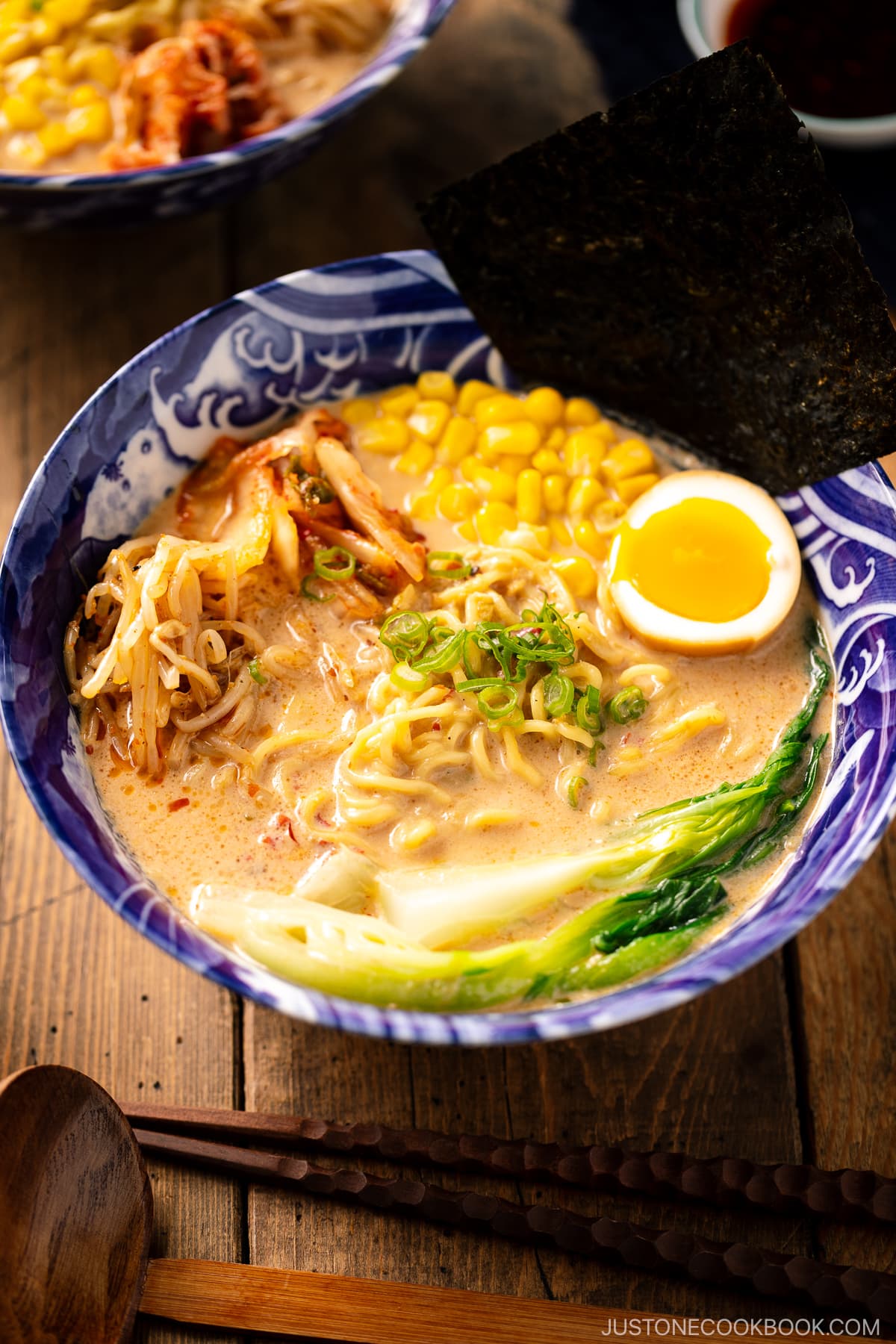
4 Key Ingredients for the Soup Broth
The following 4 ingredients are very important to make a bowl of authentic vegetarian ramen broth Please do not substitute.
1. Soy Milk

To create a vegetarian ramen broth that is smooth, rich, and creamy, the secret lies in plant-based soy milk. The use of soy milk also adds color, depth, and a hint of delicate sweetness that rounds up the flavor of the soup.
Hopefully, even if you’re not vegetarian, I could convince you to try this rich and creamy delicious ramen by the end of this post. The best part? The soup broth takes less than 20 minutes to make!
2. Vegan Dashi – Umami Packed Broth

To make umami-packed broth, we’ll make Vegan Dashi (精進だし) with kombu and dried shiitake mushroom. Both ingredients are packed with umami substance and they are essential for this recipe.
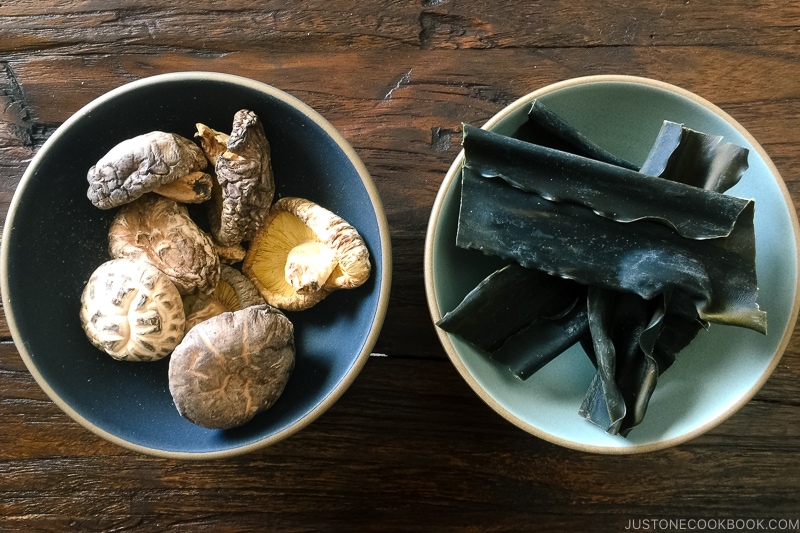
If you’re not vegetarian/vegan, you can use Awase Dashi (with kombu and bonito flakes) and/or chicken stock instead.
3. Miso

Miso (味噌) is a Japanese fermented soybean paste and the tub shown above is my favorite brand of miso. There are different kinds of miso and if you are not sure which one to pick, get Awase miso (the combination of red + white miso) or Koji miso (my favorite). They work great for almost all recipes that call for miso. More about miso on this page.
4. Doubanjiang (Spicy Bean Paste)

To make a vegetarian broth that is robust in flavor, doubanjiang (豆板醤) or spicy bean paste is a necessary ingredient.
Doubanjiang is a combination of fermented broad beans, soybeans, and hot chilies. The salty, savory, umami-rich paste adds an incredible depth and character to the broth that you should not substitute. You can add more if you like your soup to be spicy, but a small amount would be enough to give it a good kick.
Did you know that there is non-spicy doubanjiang? Taiwan, Hong Kong, and Guangdong in China have non-spicy doubanjiang. It has the same savory depth but without the heat.
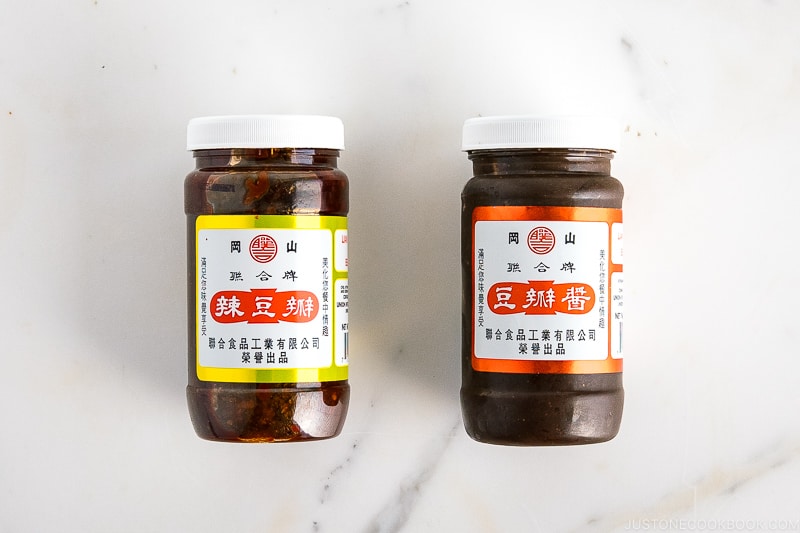
When the kids were small, I used non-spicy doubanjiang to make my Mapo Tofu. Taiwanese brands like Kangshan (岡山) (shown above) and Ming Teh (明德) offer the doubanjiang made from fermented broad beans and soybeans, and they usually have both spicy and non-spicy versions.
You can get these Taiwanese brands at a local Chinese grocery store. Amazon does not sell the non-spicy doubanjiang at this time (please let me know if you find one).
- Ming Teh Doubanjiang (non-spicy)
- Kangshan Doubanjiang (non-spicy) – Walmart
- Kangshan Doubanjiang (non-spicy) – Weee!
Doubanjiang Substitute: If you really can’t find doubanjiang, you can use gochujang (Korean chili paste; spicy) or doenjang (Korean soybean paste; non-spicy). However, please keep in mind that these pastes will yield slightly different flavor profiles.

Fresh Ramen Noodles
Fresh ramen noodles are made from four ingredients: wheat flour, water, salt, and kansui. Despite the yellowish color, the noodles do not contain eggs. Kansui, an alkaline solution, is what gives ramen its yellow tint and springy texture.

- Ramen noodles are either straight (ストレート麺) or wavy (ちぢれ麺). Generally, straight noodles are used for tonkotsu ramen while wavy noodles are used for soy sauce ramen, salt ramen, and miso ramen, but of course, there are exceptions.
- Ramen noodles have 6 different thicknesses: ultra-thin (極細麺), thin (細麺), medium-thin (中細麺), medium-thick (中太麺), thick (太麺), and extra thick (極太麺).
Where to Buy the Ramen Noodles
Big Japanese grocery stores like Mitsuwa, Nijiya, and Marukai (Tokyo Central) sell packages of fresh ramen noodles (with or without soup packages included). Some large Korean and Chinese grocery stores also carry packages of fresh ramen noodles from Myojo and Yamachan Ramen.
Sun Noodles make great noodles and they ship domestically!

If you don’t have access to fresh ramen noodles, you can purchase dried ramen noodles (what we call Chukamen, 中華麺) by the HIME brand at Japanese or Asian grocery stores or Amazon.
If you are looking for gluten-free noodles, check out my favorite vegan-friendly ramen noodles by Gluten Free Meister (Kobayashi Seimen).
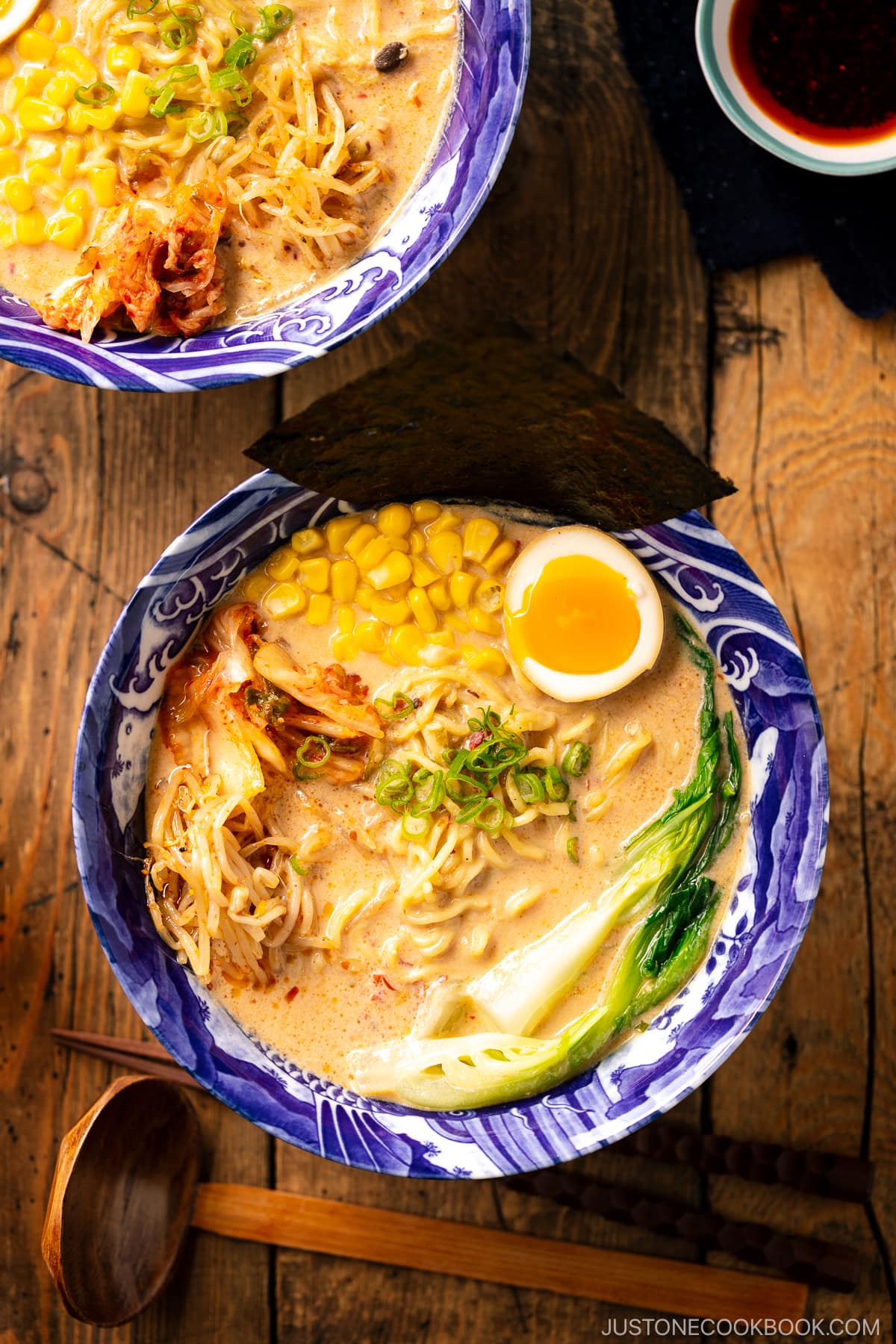
Various Ramen Toppings
If you want to stick with the traditional ramen toppings, I recommend:
- Ramen egg (skip for vegan)
- Scallions (green onions)
- Sweet corn
- Wood-ear mushrooms
- Menma (seasoned bamboo shoots)
- Bean sprouts (I used my Spicy Bean Sprout Salad today)
- Seaweed (nori)


However, feel free to enjoy your ramen with what you have on hand. You can use any ingredients that complement the ramen broth and ramen noodle texture. Some of the examples that go well with your ramen include:
- Homemade vegetarian kimchi (I recommend my friend Seonkyoung’s vegan kimchi recipe)
- Blanched Shanghai bok choy, baby bok choy, or spinach
- Colorful veggies like julienned carrots
- Deep-fried tofu
- Shelled edamame
There is plenty of flexibility to work with!

How to Make Vegetarian Ramen
Ingredients You’ll Need
- Toasted white sesame seeds
- Aromatics including garlic, ginger, and scallions
- Roasted sesame oil
- Doubanjiang (spicy chili bean sauce/broad bean paste) (more below)
- Miso (more below)
- Sake
- Soy Sauce
- Vegan dashi made with water, kombu, and dried shiitake mushrooms (more below)
- Unsweetened soy milk (more below)
- Salt and white pepper powder
- Fresh ramen noodles (more below)
- Toppings: Blanched Shanghai bok choy, Ramen Eggs (skip for vegan), vegan kimchi, sweet corn, Spicy Bean Sprout Salad
Overview: Cooking Steps
- Make the cold brew vegan dashi by soaking kombu and dried shiitake mushrooms in water.
- Then, bring the cold brew dashi in a pot to almost a boil. Discard the kombu and mushrooms and set the dashi aside.
- In a separate saucepan, cook the aromatics with sesame oil and add all the condiments, prepared vegan dashi, and soy milk.
- Cook the Shanghai bok choy and fresh ramen noodles.
- Assemble each ramen bowl with the noodles, soup, and toppings. Serve hot!
If You’re Not Vegetarian or Vegan…
If you are not vegetarian or vegan, you can cook 4 oz or 113 g of minced pork (for two servings) after stir-frying the aromatics (ginger, garlic, and scallion). The meat will give more complexity to the soup broth.

You can also add Chashu as a topping. The bottom line is to use my recipe as a guide and create your own version!
What to Serve with Vegetarian Ramen
- Vegetable Gyoza
- Homemade La-Yu
- Yakitori-style Grilled Vegetables
- Spicy Edamame
- Pickled Mustard Greens Fried Rice (Takana Chahan)
I hope this Vegetarian Ramen will be your go-to recipe. Once you’ve tried it, leave a comment below and let me know how it goes.

FAQs
How long does it take to make this vegetarian ramen?
Really fast! If you prepare the cold brew dashi in advance, you can make this ramen in 30 minutes from start to finish. Make sure to read the recipe and understand the process ahead of time.
Is Soy Milk Ramen (Tonyu Ramen) always vegetarian/vegan?
No. When you visit Japan and order Soy Milk Ramen or Tonyu Ramen, make sure that it is vegetarian/vegan. Tonyu ramen is not necessarily vegetarian or vegan-friendly in Japan.
“Soy milk” in the ramen is considered one of the flavor options like miso, shoyu (soy sauce), and shio (salt). It’s easier to spot meat as a topping, ask if the soup broth are made with pork bone (Tonkotsu 豚骨), chicken carcass (Torigara 鶏ガラ), bonito flakes (Katsuobushi 鰹節), or other types of fish (such as ago アゴ).
Is it easy to find vegetarian ramen in Japan?
Vegetarian ramen is not typically found on the standard menus that ramen shops offer. However, with the increasing number of foreign tourists, you’ll be able to find more vegetarian and vegan options in larger cities. Check or ask in advance.
Are ramen noodles vegan?
The traditional ramen noodles are made with wheat flour, salt, water, and kansui, and they are vegan. But not all ramen noodles are vegan. Occasionally, some ramen shops create noodles with eggs. So, you should definitely ask or check the ingredients.
More Delicious Ramen Recipes You’ll Love

- Miso Ramen
- Shio Ramen
- Spicy Shoyu Ramen
- Tan Tan Ramen (Tantanmen)
- Tan-Men (The Easiest Ramen Soup Noodle)

Wish to learn more about Japanese cooking? Sign up for our free newsletter to receive cooking tips & recipe updates! And stay in touch with me on Facebook, Pinterest, YouTube, and Instagram.
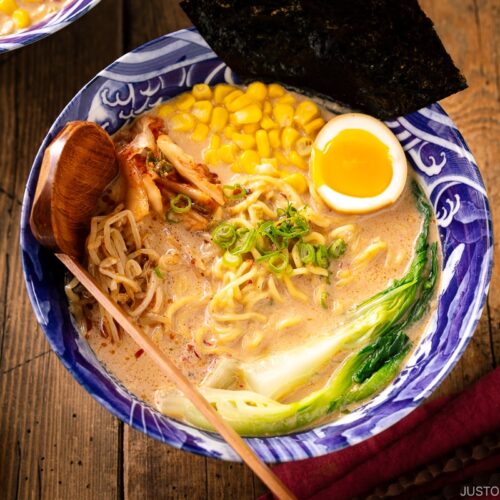
Vegetarian Ramen
Video
Ingredients
For the Soup Broth
- 2 Tbsp toasted white sesame seeds
- 1½ tsp ginger (grated; from a 1-inch, 2.5-cm knob)
- 2 cloves garlic
- 2 green onions/scallions (save the green part for garnish)
- 1 Tbsp toasted sesame oil
- 1½ Tbsp doubanjiang (spicy chili bean paste) (use either the spicy or non-spicy type, or use gluten-free doubanjiang)
- 1½ Tbsp miso (I use my favorite miso by Hikari Miso; most types will work, except Saikyo and Hatcho varieties)
- 1 Tbsp sake
- 1½ Tbsp soy sauce (use GF soy sauce for gluten-free)
- 2 cups unsweetened soy milk
- 1 cup Vegan Dashi (use my Vegan Dashi recipe or follow the instructions below)
- ½ tsp Diamond Crystal kosher salt
- 1 dash of white pepper powder
For the Ramen
- 2 servings fresh ramen noodles (10–12 oz, 283–340 g fresh noodles; 6.3 oz, 180 g dry ramen noodles; use GF ramen noodles for gluten-free)
- 1 head Shanghai bok choy (large)
- toppings of your choice (I like to add ramen eggs (skip for vegan), corn, nori seaweed, vegan kimchi, and spicy bean sprout salad; see the instructions for details)
Instructions
- Gather all the ingredients. If you haven‘t already made the vegan dashi, prepare my Vegan Dashi recipe or follow the instructions below. Make sure all the toppings are ready to go before you begin cooking the ramen. If you‘re making my Ramen Eggs recipe (1 per bowl), prepare them a day in advance. I also like to divide and add ½ cup of my Spicy Bean Sprout Salad and ¼ cup of my friend Seonkyoung‘s homemade vegan kimchi. Finally, ¼ cup corn (frozen or canned) and 1 sheet nori (dried laver seaweed) are other popular toppings to divide among the bowls.

- A typical ramen bowl can hold 1200–1400 ml of liquid. We will prepare 1½ cups (360 ml) of soup broth per bowl, which should be more than enough. If you’re using bigger bowls, you may need to prepare extra soup.

To Make the Vegan Dashi
- Measure 1 cup (240 ml) of water. Add 1–2 dried shiitake mushrooms (3–5 g each) and 1 piece of kombu (dried kelp) (5 g; 2 x 2 inches, 5 x 5 cm per piece). I set a small heavy cup or bowl on top to keep the mushrooms completely submerged in the water. Soak for at least 30 minutes. Meanwhile, prepare the ramen ingredients. Tip: Use less mushroom if they are thick and large and more if they are flat and small.

- After 30 minutes, transfer this cold brew vegan dashi (the liquid, kombu, and shiitake) to a medium saucepan.

- Slowly bring it to a near boil over low heat; this slow extraction will enhance the dashi flavor. Right before the liquid boils, remove the kombu and shiitake mushroom from the dashi. Turn off the heat. Tip: If you leave the kombu in the pot, the dashi will become slimy and bitter.

- Transfer the vegan dashi to a measuring cup. Make sure you have 1 cup; if not, add water.

- Tip: You can repurpose the spent kombu to make Simmered Kombu (Kombu Tsukudani) and Homemade Furikake (Rice Seasoning). Cut off the stem of the spent shiitake mushroom and use the cap just as you would a fresh shiitake mushroom.

To Prepare the Ingredients
- Prepare a big pot of water for cooking the bok choy and noodles. Slowly bring it to a boil on medium-low heat while you prepare all the ingredients.
- Grind and crush 2 Tbsp toasted white sesame seeds in a Japanese mortar and pestle (suribachi and surikogi).

- Grate the ginger (I use a ceramic grater). Reserve 1½ tsp ginger (grated, with juice). If you’re unsure how much ginger flavor you’d like, start with less and add more later.

- Next, mince or press 2 cloves garlic (I use a garlic press).

- Separate the green and white parts of 2 green onions/scallions. Cut the white part (for the soup broth) into thin rounds.

- Then, cut the green part (for the garnish) into thin rounds. Keep them in separate bowls.

- Cut 1 head Shanghai bok choy into quarters lengthwise and rinse clean under water. Debris tends to hide between the layers, so rinse them thoroughly.

To Make the Soup Broth
- Set a small saucepan over medium-low heat. Add 1 Tbsp toasted sesame oil, the minced garlic, the grated ginger, and the white part of the green onions/scallions. Cook until fragrant, about 1–2 minutes. Tip: Make sure not to burn the aromatics.

- Add 1½ Tbsp doubanjiang (spicy chili bean paste) and 1½ Tbsp miso to the saucepan. Stir constantly so that they don’t burn. Tip: Try different miso types to create a slightly different flavor for the soup broth. For information on doubanjiang substitution, see the blog post.

- Next, add 1 Tbsp sake and use a wooden spatula to stir and release the bits of the sauce attached to the bottom of the saucepan.

- Add the ground sesame seeds and 1½ Tbsp soy sauce and mix it all together.

- Gradually add 2 cups unsweetened soy milk, stirring constantly and making sure to dissolve the doubanjiang and miso.

- Then, add 1 cup Vegan Dashi.

- Taste the soup now and adjust the seasoning with ½ tsp Diamond Crystal kosher salt and 1 dash of white pepper powder, to taste. Don‘t be shy about adding salt because the broth will taste less salty after you add the noodles. Turn off the heat, cover with a lid, and set aside.

To Blanch the Bok Choy
- Prepare a medium bowl of cold water and set aside. In the big pot of boiling water, add the bok choy, stem end first, and cook it for 2 minutes. When the bottom end is tender, turn off the heat.

- Without draining the water, remove the blanched boy choy from the pot and transfer it to the bowl of cold water to stop the cooking. Keep the hot water in the big pot to cook the noodles in the next step. Once the bok choy is cool enough to handle, squeeze the water out and set aside.

To Reheat the Broth and Cook the Noodles
- Now, it‘s time to reheat the soup broth until it‘s piping hot, but don‘t let it overboil because it may curdle. Before cooking the fresh noodles, loosen them up with your hands.

- Turn the heat back on for the big pot of water and bring it to a boil again. Once boiling, add 2 servings fresh ramen noodles and cook according to the package instructions. While cooking, stir and separate the noodles with chopsticks. Here, I cook the noodles inside a big noodle strainer (I got it in Japan) that I’ve set inside the pot.

- When the noodles are done cooking, drain them well in a strainer, shaking it a few times to drain the water thoroughly (otherwise it will dilute the soup broth). Transfer the noodles to the individual ramen bowls.

To Serve
- Divide and pour the piping-hot soup broth with seasonings over the noodles. Then, divide and add the bok choy and toppings of your choice to the bowls. I topped this Vegetarian Ramen with 2 ramen eggs sliced lengthwise, ¼ cup frozen or canned corn, 1 sheet nori (dried laver seaweed), ½ cup Spicy Bean Sprout Salad, and ¼ cup vegan kimchi. Garnish with the chopped green onions and serve.

To Store
- You can keep the soup broth in the refrigerator for 3 days. Cook the noodles right before serving.
Nutrition
Editor’s Note: This post was originally published on Nov 18, 2015. It was updated with new pictures, an updated recipe (for two servings, instead of one), and more helpful content on April 9, 2023. It has been republished with a new video on October 20, 2023.


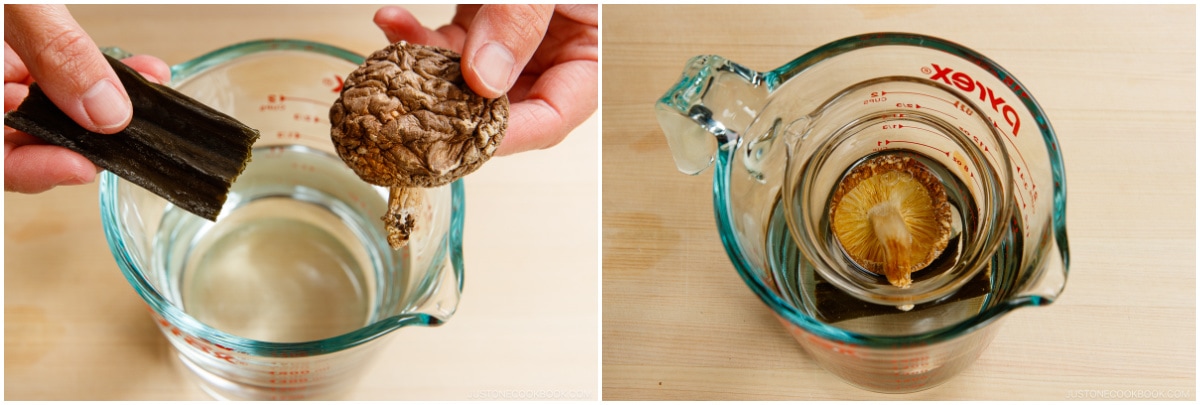





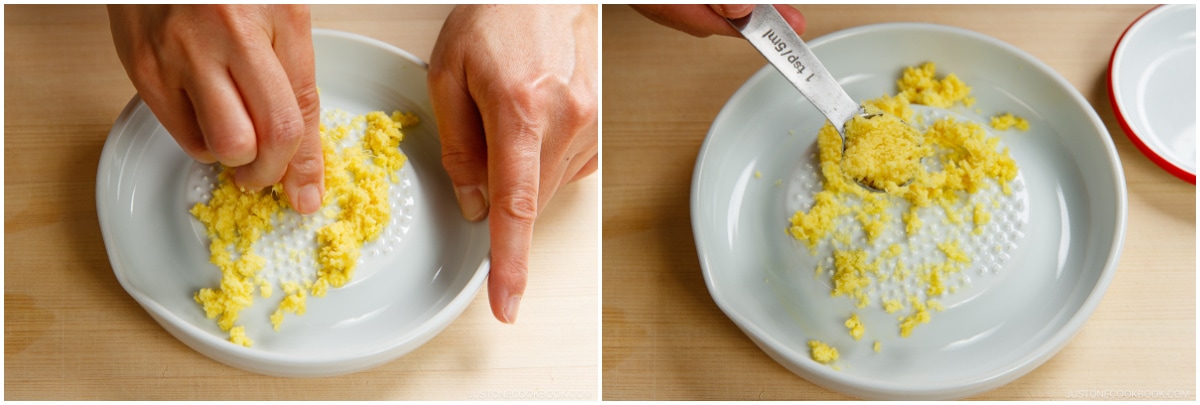
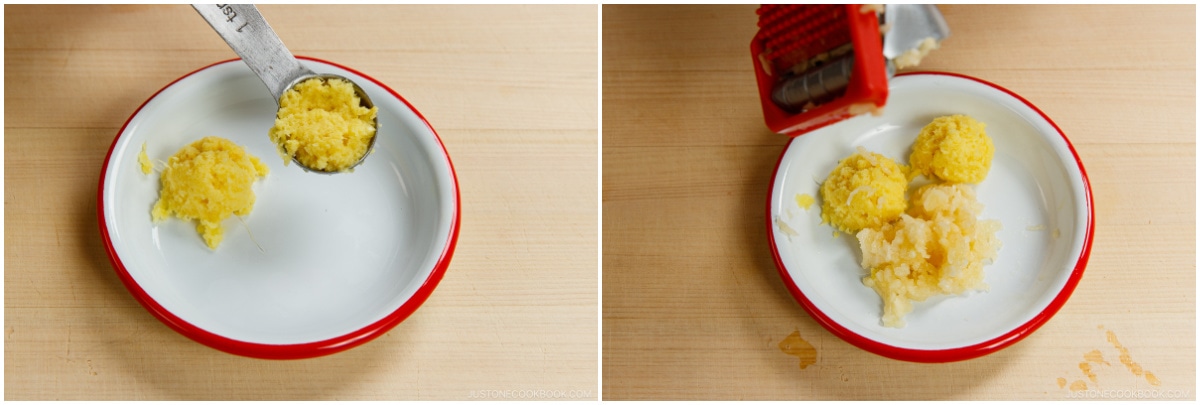










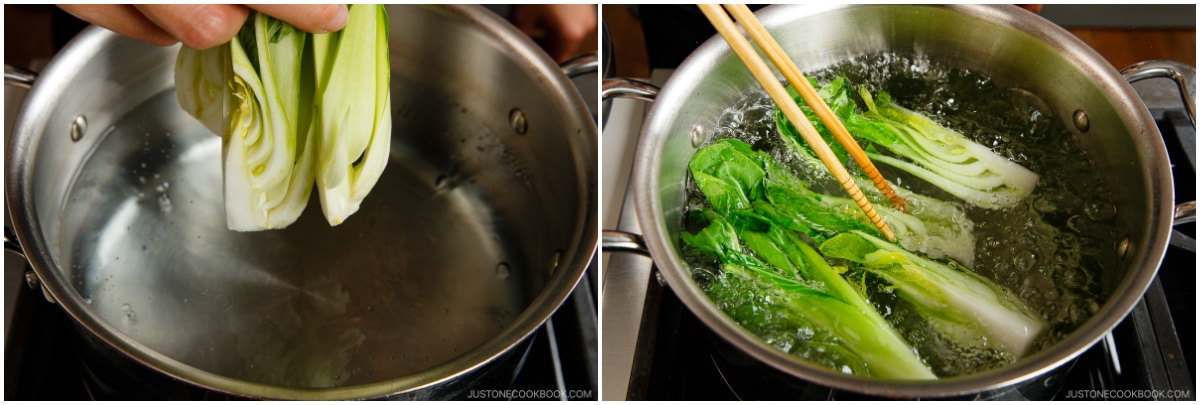




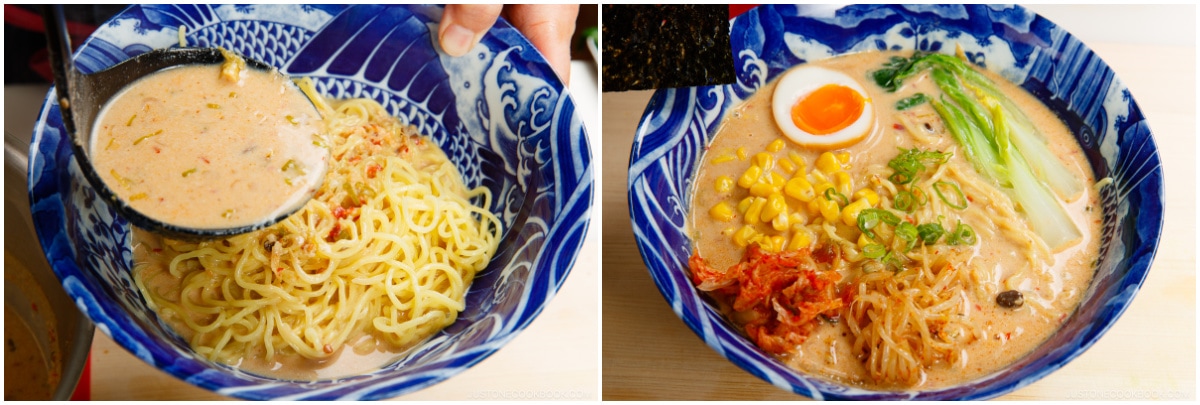












I don’t know how farely I can rate this as I made many changes but I still give it a 5 star because it helped me make a perfect recipe for dinner! I didn’t have soy milk on hand so I used oat. I didnt have sake so I used mirim. I used gochujang again because that’s what I had on hand and as I was making it to share with my 3yo I use 1/2tsp of gochujang and it wasn’t spicy at all. I also didn’t have the ingredients to make the dashi so I just used vegetable stock powder in water haha but all in all it was an awesome dinner thank you! I also used your recipe to boil some eggs to go with but as I was wanting it now I couldn’t marinate the eggs over night, so I just boiled them with your instructions and had a perfectly cooked custardy yolk thank you!
Hi Carmen! Thank you so much for reading Nami’s post and sharing your cooking experience!
We are so happy to hear that everything came out great and you and your family enjoyed the Ramen!
Happy Cooking!
Going to be trying this recipe this weekend and was wondering if adding a shoyu to it work work. I have a simple shoyu I made and think it might work as there isn’t much salt in the rest of the recipe. I wanted to ask what you would think of adding shoyu to it on how it would go?
Hi, Nicolas. Thank you for experimenting with Nami’s recipe.
Yes, if you prefer a stronger soy sauce flavor, you can add more soy sauce (Shoyu). Why not start by making the broth according to the recipe? If you think you want more soy sauce flavor, start with a small amount in a small bowl. Soy sauce can always be added later. We hope you enjoy our freshly prepared Ramen!
Hello, im preparing to start this recipe for the first time, however, there is something about the quantity of the ingredients i dont understand. In the first section of the list of ingredients x1 you ask 180ml of water and then for the soup broth 120ml of Dashi. Does it mean you need:
– 180ml +120ml?
– Or only the 120ml out of the 180? If this is it what do you do about the remaining 60ml?
Please help 🙂
Hi, Vincent! Thank you for trying Nami’s recipe!
This recipe calls for 180 ml of water to make the dashi. You may lose the Dashi amount due to evaluation during the dashi preparation process, which is why Nami included the extra liquid amount. If you have any leftover dashi after preparing it, you can use it in another recipe. 😉 We hope this was helpful!
I made this tonight, my first ramen I’ve ever made and my first time making a runny egg. I had so much fun at the Asian market. This entire process was so enjoyable and eye opening. And the outcome was even better than I expected. Thank you for such a helpful , detailed, and organized way of explaining and walking us through these recipes!
Hi Bethany! Aww.🥰 Nami and all of us JOC are so happy to hear you enjoyed cooking.
Thank you so much for trying Nami’s recipe and leaving such lovely feedback. ❤️
Happy Cooking!
I am planning on making this for a dinner party, based on some of the comments, I’ll probably reduce the soy milk. My main question is though, can I make the broth (not just the dashi) a day in advance, reheat it and add the ramen and topping just before serving?
Hi Sophia! Thank you for reading Nami’s post and trying her recipe!
The Miso loses its flavor and changes the flavor of the soup the next day, so it’s best to make it on the same day.
We hope this helps!
This is the most incredible ramen I have every made! I was genuinely shocked at how well this turned out! It was soooo easy too! THANK YOU!
Hi Lauren! Thank you very much for trying Nami’s recipe and for your kind feedback!
We are so happy to hear you enjoyed Homemade Vegetarian Ramen.
Happy Cooking! 🤗
Hi! I’m trying to make a big pot of this broth but the soy milk keeps curdling. I’ve already tried gradually pouring it in to make sure the temperature of the soy milk doesn’t get too hot but it still ends up curdling as it simmers. Any tips for this? Thank you!
Hi Jasmine! Thank you very much for trying Nami’s recipe!
Our suggestion is to shorten the time of simmering after you mix the soy milk into doubanjiang and miso paste because the acidity of the ingredients causes the soy milk to curdle.
We hope this helps!
Hello, this recipe looks amazing and I’d like to try it, but I usually avoid non-fermented soy products. Is it possible to replace soy milk with some other plant-based milk, like rice or almond milk?
Hi Elizabeth! Thank you for reading Nami’s post and trying her recipe!
Creamy Almond milk or oat milk should work fine.😉
We hope this helps!
Hello, we tried a bunch of vegetarian recipes for ramen, but they were never satisfying. This really hit the spot. Went straight into our recipe collection.
Hi Julius! Thank you for trying Nami’s recipe and for your kind feedback!
We are so happy to hear you enjoyed Ramen!
Happy Cooking! 🤗
I’m becoming addicted to ramen and was always making a simpler version of it (just noodles, white miso, sesame oil, ginger, soy sauce) and some toppings) so I thought I should step up my ramen game. The process of making this was really fun and it tastes really good and complex. I think the ginger and chilli were a bit too hot for me (perhaps I didn’t measure it properly, or its a matter or brand) and my kombu didn’t arrive yet, so I will definitely make some versions of this to try!
Hi Ana! Thank you for reading Nami’s post and trying her recipe!
We are so happy to hear you enjoyed making this Vegetarian Ramen and loved the flavor.😊
Happy Cooking!
I’ve made this recipe a few times, as well as the shoyu ramen and regular miso ramen. I’ve followed the recipe and exact same ingredients, even brands, it tastes good but there’s a sour/metal taste at the end, every time happens the same. What I might be doing wrong?
Hi Laura! Thank you for trying Nami’s recipe!
Have you tasted Doubanjiang itself? This condiment is in all the ramen recipes that you tried. The sour/metal taste could be from that. What do you think? 🤔
Your recipes never fail to amaze me, Nami! I made this today for lunch for my family of four (and so I quadrupled the recipe) and we all agreed it was just as good, if not better than, Kizuki Ramen’s miso ramen! I never would’ve guessed that soy milk is the secret ingredient for creamy vegetarian miso broth. Thank you for sharing your recipes with us! We are definitely fans!
Hi Kim! Thank you for trying many of Nami’s recipes and for your kind feedback!
We are so happy to hear you enjoyed the creamy vegetarian miso broth.☺️
Happy Cooking!
I left out half the broth ingredients (the kombu, the sake, the soy milk) and it was still phenomenal! Fully recommend 👍
Hi Bumblebun, Thank you very much for your kind feedback!
We are glad to hear you enjoyed the dish.🙂
Loved this recipe. Prep time is less, but including cooking time, it took me about 2 hour from start to finish. I had to dilute the soy milk with water (plus dashi) coz it was too rich for me. Enjoyed the end result 😁
Hi Kumar! We are so happy to hear you enjoyed the result of Vegetarian Ramen! ☺️
Thank you very much for trying Nami’s recipe and sharing your cooking experience with us!
this looks delicious. I’m trying to make this as a part of my circle’s potluck. Can we make dashi broth in advance and then use them to make broth at my friend’s place?
Hi Anh! Of course! 🙂 You can make dashi in advance.
We hope you and your friends enjoy this recipe!
Happy Cooking!